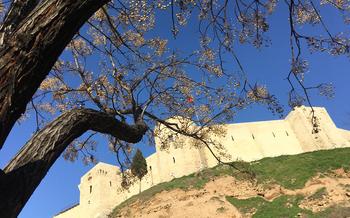
Nizip Historical Stone Bridge
- The Antiquity of Nizip Historical Stone Bridge
- The Bridge's Enduring Legacy
- A Testament to Engineering Excellence
- A Journey Through Time
- Exploring the Bridge's Surroundings
- A Haven for Nature Lovers
- A Culinary Adventure
- A Photographer's Paradise
- A Place for Reflection
- A Cultural Tapestry
- A Symbol of Resilience
- A Source of Inspiration
- A Bridge to the Future
- Insider Tip:
The Antiquity of Nizip Historical Stone Bridge
The Nizip Historical Stone Bridge stands as a testament to the rich history and architectural prowess of Gaziantep, Turkey. Constructed during the Roman era, the bridge has endured for centuries, silently witnessing the ebb and flow of civilizations. Built using locally sourced limestone, the bridge's sturdy construction showcases the Romans' mastery of engineering. Its elegant arches, supported by massive stone buttresses, reflect the architectural style prevalent during that era, blending functionality with aesthetic appeal.
The Bridge's Enduring Legacy
Throughout history, the Nizip Historical Stone Bridge has played a pivotal role in trade and transportation, facilitating the movement of goods and people across the Nizip River. Its strategic location along ancient trade routes made it a vital link between different regions, contributing to the economic prosperity of the area.
Over the centuries, the bridge has witnessed countless stories and legends, becoming an integral part of the local folklore. Tales of brave travelers, merchants seeking fortune, and lovers crossing paths on the bridge have been passed down through generations, adding to its mystique.
To the people of Gaziantep, the bridge holds deep cultural significance, representing their rich heritage and resilience. Its enduring presence has made it a symbol of the city's identity, a landmark that evokes a sense of pride and belonging among the locals.
In recognition of its historical and cultural importance, the Nizip Historical Stone Bridge has been included in the UNESCO World Heritage Tentative List, a testament to its outstanding universal value and the international recognition it has garnered.
A Testament to Engineering Excellence
The Nizip Historical Stone Bridge showcases remarkable engineering prowess and innovation. Constructed using locally sourced stones and mortar, the bridge features a series of arches that distribute the weight of the structure evenly, ensuring its stability and longevity. The bridge's buttresses, which act as supporting structures, further enhance its resilience against the elements.
One of the bridge's notable features is its innovative use of arches. The arches, which are semi-circular in shape, create a graceful curve that not only adds to the bridge's aesthetic appeal but also serves a functional purpose. The arches help to reduce the stress on the bridge's piers, allowing it to withstand the force of the river's current and the weight of heavy traffic.
The Nizip Historical Stone Bridge stands as a testament to the ingenuity and skill of its builders. Its resilience to natural disasters, such as earthquakes and floods, is a testament to the quality of its construction and the care taken in its maintenance. Despite its age, the bridge continues to function as a vital transportation route, connecting the city of Nizip to the surrounding region.
A Journey Through Time
The Nizip Historical Stone Bridge has witnessed countless historical events throughout its existence. From the rise and fall of empires to the passage of armies and traders, the bridge has stood as a silent observer. The changing landscape around the bridge reflects the passage of time. Once a strategic crossing point on the trade route between the East and the West, the bridge now stands amidst fields and orchards. The bridge has played a crucial role in connecting different cultures and civilizations. Its strategic location has facilitated the exchange of ideas, goods, and traditions between diverse communities. The bridge serves as a tangible link to Gaziantep's rich and storied past, a testament to the enduring legacy of this ancient city.
Exploring the Bridge's Surroundings
Beyond the Nizip Historical Stone Bridge itself, visitors can immerse themselves in the rich cultural and historical tapestry of the surrounding area. A short stroll from the bridge leads to the vibrant Nizip Bazaar, a bustling marketplace where locals and tourists alike can experience the sights, sounds, and flavors of traditional Turkish commerce. Here, visitors can haggle for unique souvenirs, savor the aromas of freshly baked goods, and indulge in delicious local delicacies.
A visit to the Nizip Museum offers a fascinating glimpse into the region's past. This treasure trove of local history and culture houses an impressive collection of artifacts, including ancient pottery, intricate textiles, and historical documents that shed light on the rich heritage of Nizip and its surroundings.
For those seeking a deeper dive into the region's ancient past, the Gaziantep Zeugma Mosaic Museum is a must-visit. Located just a short drive from the bridge, this world-renowned museum boasts a stunning collection of ancient mosaics that once adorned the floors of Roman villas in the nearby ancient city of Zeugma. These exquisite works of art depict scenes from mythology, history, and everyday life, offering a glimpse into the lives of the people who inhabited this region centuries ago.
Enhancing the region's historical allure are nearby sites like the Gaziantep Castle and the Rumkale Fortress. Perched atop a hill overlooking the city, the Gaziantep Castle is a formidable testament to the region's rich military history. Its imposing walls and towers have stood guard over Gaziantep for centuries, witnessing the ebb and flow of empires and civilizations.
A short drive from the bridge, the Rumkale Fortress stands as a testament to the region's Byzantine heritage. Situated on a rocky outcrop overlooking the Euphrates River, this once-mighty fortress played a crucial role in defending the Byzantine Empire from invading forces. Its well-preserved ruins offer visitors a glimpse into the strategic importance of this region throughout history.
A Haven for Nature Lovers
The Nizip Historical Stone Bridge is not just a historical landmark; it's also a haven for nature lovers. The lush greenery surrounding the bridge creates a tranquil oasis, making it an ideal spot for relaxation and contemplation. The area is home to a variety of bird species, making it a paradise for birdwatching and nature photography enthusiasts. Visitors can spend hours observing the diverse birdlife, capturing stunning photographs, and simply enjoying the serene atmosphere. The bridge offers a unique opportunity to immerse oneself in nature's beauty while exploring a historical marvel.
A Culinary Adventure
Gaziantep is renowned for its rich and flavorful cuisine, and no visit to the city is complete without sampling its culinary delights. The area surrounding the Nizip Historical Stone Bridge is a foodie's paradise, with a tempting array of restaurants and cafes offering panoramic views of the bridge and the surrounding landscape.
Indulge in the famous Gaziantep baklava, a sweet pastry made with layers of filo dough, chopped nuts, and syrup. Savor the smoky flavors of lahmacun, a thin, crispy flatbread topped with minced lamb, tomatoes, onions, and spices. Don't miss the tantalizing kebabs, succulent grilled meats served with fresh vegetables and aromatic spices.
For a truly unforgettable dining experience, choose a restaurant with a terrace overlooking the bridge. As you savor the delicious food, let the gentle breeze caress your skin and the mesmerizing views of the bridge transport you to another era.
To fully immerse yourself in the local culinary scene, venture into the nearby Nizip Bazaar, a vibrant marketplace brimming with fresh produce, spices, and traditional delicacies. Engage with the friendly vendors, learn about local ingredients, and pick up some culinary souvenirs to recreate the flavors of Gaziantep back home.
Whether you're a seasoned foodie or simply curious about Turkish cuisine, the area around the Nizip Historical Stone Bridge is a culinary adventure waiting to be savored.
A Photographer's Paradise
The Nizip Historical Stone Bridge is not just a historical landmark; it's also a photographer's paradise. The bridge's picturesque setting, surrounded by lush greenery and the meandering Nizip River, offers endless opportunities for capturing stunning images.
Photographers are drawn to the bridge for its unique architectural features, such as the graceful arches, intricate carvings, and towering buttresses. The contrast between the ancient stonework and the vibrant natural surroundings creates a visually captivating scene.
The bridge is particularly stunning during sunrise and sunset, when the warm golden light bathes the structure in a soft glow. The reflections of the bridge in the water, along with the silhouettes of birds in flight, make for unforgettable photographs.
To capture the best shots of the bridge, it's important to consider the angle and composition. Experiment with different perspectives, such as shooting from the riverbank, on the bridge itself, or from a nearby hilltop. Using a wide-angle lens can help capture the bridge's grandeur, while a telephoto lens can be used to focus on specific details.
For those interested in capturing the bridge's historical essence, it's worth exploring the surrounding area. The Nizip Bazaar, with its colorful stalls and bustling atmosphere, provides a glimpse into the region's vibrant culture. The nearby Nizip Museum houses a collection of artifacts that shed light on the bridge's rich history.
Whether you're an amateur photographer or a seasoned professional, the Nizip Historical Stone Bridge offers a wealth of photographic opportunities. So bring your camera, unleash your creativity, and capture the timeless beauty of this architectural masterpiece.
A Place for Reflection
The Nizip Historical Stone Bridge is not just a historical landmark but also a place for contemplation and introspection. The tranquility of the surroundings and the timeless beauty of the bridge create an atmosphere that is conducive to self-reflection and personal growth. Standing on the bridge, one can't help but feel a sense of awe and wonder at the enduring legacy of this ancient structure. It is a reminder of the resilience and perseverance of the human spirit, and of the importance of preserving our cultural heritage. The bridge invites visitors to take a step back from the hustle and bustle of everyday life and to connect with their inner selves. Whether one is seeking solace, inspiration, or simply a moment of peace, the Nizip Historical Stone Bridge offers a unique and transformative experience.
A Cultural Tapestry
Gaziantep, where the Nizip Historical Stone Bridge stands tall, is a city steeped in a rich and diverse cultural heritage. The region has been a crossroads of civilizations for centuries, with influences from various cultures, including Turkish, Arab, Kurdish, and Armenian. This melting pot of cultures has shaped Gaziantep's unique identity, which is reflected in its cuisine, music, dance, and art.
The Nizip Historical Stone Bridge itself is a testament to this cultural diversity. It was built by the Romans, who ruled the region for several centuries. Over time, the bridge was modified and expanded by subsequent rulers, each adding their own unique touches. As a result, the bridge showcases a blend of architectural styles, reflecting the diverse influences that have shaped Gaziantep's history.
The bridge is not just a historical monument but also a symbol of cultural exchange and harmony. Throughout history, it has served as a meeting point for people from different backgrounds and cultures. Traders, travelers, and pilgrims from all over the region crossed the bridge, bringing with them their ideas, customs, and traditions. This exchange of ideas and cultures has contributed to the vibrant and cosmopolitan atmosphere that characterizes Gaziantep today.
To fully immerse yourself in Gaziantep's cultural tapestry, be sure to visit the local festivals and events that showcase traditional music, dance, and art. These events are a wonderful opportunity to experience the city's rich cultural heritage firsthand and to interact with the warm and welcoming people of Gaziantep.
A Symbol of Resilience
The Nizip Historical Stone Bridge has stood the test of time, enduring wars, earthquakes, and floods. Despite these challenges, it has remained intact, a testament to the resilience and determination of the people of Gaziantep.
The bridge's resilience is particularly remarkable considering its age. Constructed over two thousand years ago, it has faced countless threats over the centuries. Yet, it has always emerged from these challenges stronger than before.
In recent years, the bridge has undergone extensive restoration efforts to preserve its historical significance. These efforts have been successful in ensuring that the bridge continues to stand as a symbol of Gaziantep's resilience and indomitable spirit.
The Nizip Historical Stone Bridge serves as a reminder of the importance of preserving historical landmarks. These landmarks are not just relics of the past; they are living testaments to the ingenuity, resilience, and cultural heritage of a people. By preserving these landmarks, we preserve our history and ensure that future generations can appreciate the achievements of their ancestors.
A Source of Inspiration
The Nizip Historical Stone Bridge has captivated the hearts and minds of many visitors throughout the ages. Its timeless beauty and grandeur have served as a source of inspiration for artists, writers, and musicians. The bridge has been featured in paintings, poems, and songs, each capturing its unique charm and significance.
Local artisans have drawn inspiration from the bridge's intricate architecture and stunning surroundings to create beautiful handicrafts and souvenirs. The bridge's story of resilience and endurance has also resonated with writers, who have woven it into their narratives as a symbol of hope and possibility.
Musicians have been moved to compose melodies that evoke the bridge's grandeur and its role in connecting people and cultures. The bridge's presence has added a layer of enchantment to the already vibrant cultural landscape of Gaziantep, inspiring creative minds to explore new depths of expression.
Whether it's through art, literature, or music, the Nizip Historical Stone Bridge continues to inspire and captivate those who encounter it. It stands as a testament to the power of human ingenuity and the enduring beauty of history.
A Bridge to the Future
The Nizip Historical Stone Bridge not only connects the past to the present but also serves as a bridge to the future. It represents Gaziantep's commitment to progress and development. The bridge's inclusion in the UNESCO World Heritage Tentative List highlights its global significance and its potential to attract tourism and investment. As a gateway to the region, the bridge opens up new opportunities for cultural exchange, economic growth, and international cooperation. The Nizip Historical Stone Bridge stands as a testament to the enduring power of history and heritage to shape a region's future and inspire generations to come.
Insider Tip:
-
Early Morning or Late Afternoon Visit: For the best experience, plan your visit to the Nizip Historical Stone Bridge during the early morning or late afternoon when the temperatures are milder. The golden light of these hours enhances the bridge's beauty and creates a magical ambiance.
-
Combine with Nizip Bazaar: After admiring the bridge, immerse yourself in the vibrant Nizip Bazaar, a short walk away. This bustling marketplace offers a glimpse into the local culture, with its colorful stalls selling traditional textiles, spices, and handmade crafts.
-
Boat Tour on the Nizip River: For a unique perspective of the bridge, take a leisurely boat tour on the Nizip River. As you glide beneath the ancient arches, marvel at the bridge's grandeur from a different angle.
-
Half-Day Exploration: Dedicate at least half a day to fully explore the Nizip Historical Stone Bridge and its surroundings. This will give you ample time to wander along the bridge, soak in its history, and visit nearby attractions like the Nizip Bazaar and the Nizip Museum.









